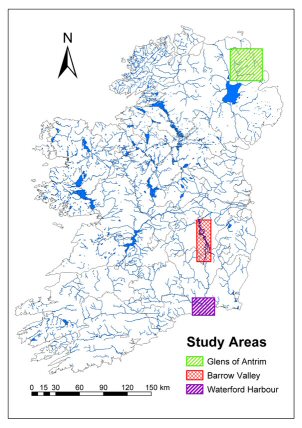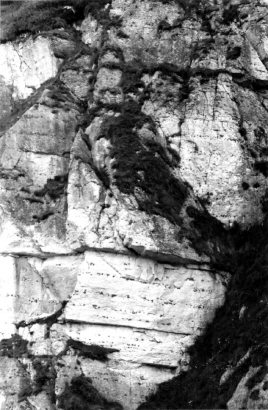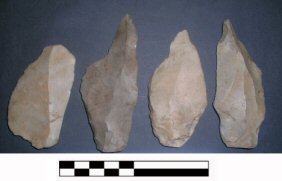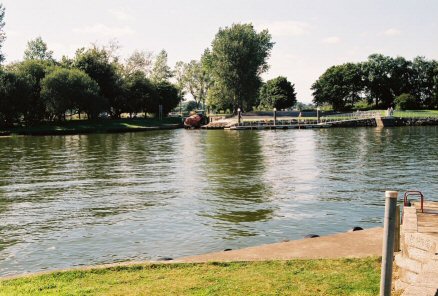

Figure 1 (left): Location map of all three case study areas
Figure 12 (right): Chalk rocks near Glenarm, County Antrim with bands of flint stretching across them.


Figure 1 (left): Location map of all three case study areas
Figure 12 (right): Chalk rocks near Glenarm, County Antrim with bands of flint stretching across them.
Finally, in northeast Ireland (Figure 1) movement of stone in later mesolithic times appears to take a highly organised form. High quality flint appears here in abundance along the coast in the form of large nodules and pebbles cropping out from the chalk (Figure 12) and washed out onto the beaches (see Figure 8 in section 4.2). Large numbers of roughed out and finished flint objects (Figure 13) but only very small amounts of cores have been identified deposited along the River Bann, which extends north-south near parallel to the coast some 40 - 60km inland. Thus the only viable explanation is that these objects found their way from the coast across the Antrim plateau and into the valley 'by human means' (Woodman and Johnston 1991-92, 134-136).

Figure 13: Typical diagnostic later mesolithic flint objects from County Antrim.
Similarly to the river Barrow, many of the find locations would appear to mark out particular places such as fording points, intersections and junctions of the river, all of which could be seen to have held specific significance in people's movements across the land. It is also interesting that other materials were transported to the same locations. Baked mudstone axes and several chert flakes, both materials probably originating some 80km to the south (Woodman 1987, 144; Woodman and Anderson 1990, 382) were brought into the valley. The traditional explanation for this has been that all these locations - the flint rich Antrim coast, the east midland plains, producing chert and mudstone, and the Bann valley, where the objects were found - represent 'stations' along people's seasonal round. This would represent in total a circuit of well above 200km. Moreover, the fact that no mudstone axes and only one chert flake are known from mesolithic find locations on the Antrim coast would speak against this assumption. It seems more likely that these places along the River Bann, marked out by deposits of various stone objects of different raw materials, brought people from different parts of the country together who in turn brought with them various artefacts made from several types of stone. Some of these locations, such as Newferry (Woodman 1977), show evidence for continuous return visits over at least 2 millennia (between c.6000 and 4000BC) spanning virtually the entire later mesolithic period. It is also interesting to note that Newferry represents the location of a fording point of the river Bann (Figure 14), highlighting the place's importance in people's movement's. Another important factor here is that materials such as carboniferous chert, which is clearly inferior to the east Antrim flint in knapping properties and durability, was transported for much greater distances than the latter. From this we can infer that people's movements and the movement of stone objects with them did not serve purely functional concerns. This finding counters any arguments that this represents evidence for logistical mobility. Instead the evidence suggests a complex and elaborate social network of people coming together and making commitments - enshrined in objects - to stay in touch with each other.

Figure 14. Newferry, County Antrim a formerly important fording point of the River Bann. The mesolithic site is just off the picture to the right (on the river's eastern bank)
© Internet Archaeology
URL: http://intarch.ac.uk/journal/issue22/2/4_3.html
Last updated: Tues Oct 2 2007